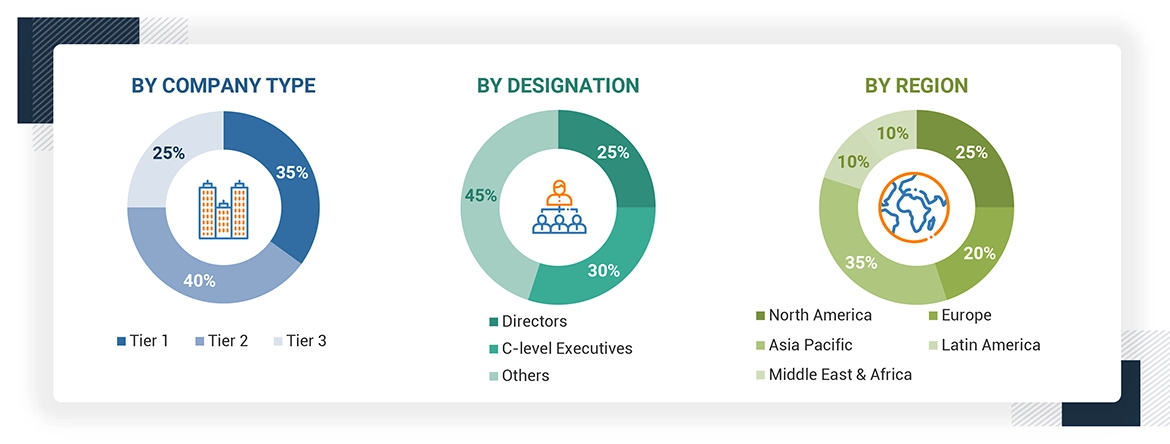The study involved major activities in estimating the current size of the DERMS market. Exhaustive secondary research was done to collect information on the peer and parent markets. The next step was to validate these findings, assumptions, and sizing with industry experts across the value chain through primary research. Both top-down and bottom-up approaches were employed to estimate the total market size. Thereafter, market breakdown and data triangulation were used to estimate the market size of the segments and subsegments.
Secondary Research
Secondary sources referred to for this research study include annual reports, press releases, and investor presentations of companies; white papers; certified publications; articles by recognized authors; and databases of various companies and associations. Secondary research was mainly used to obtain key information about the industry’s supply chain, the total pool of key players, market classification, and segmentation according to industry trends to the bottom-most level, regional markets, and key developments from both, market- and technology-oriented perspectives.
Primary Research
In the primary research process, various primary sources from the supply and demand sides were interviewed to obtain qualitative and quantitative information for this report. Primary sources from the supply side include industry experts such as chief executive officers (CEOs), vice presidents (VPs), marketing directors, and related key executives from various companies and organizations operating in the DERMS market.
In the complete market engineering process, the top-down and bottom-up approaches, along with several data triangulation methods, were extensively used to perform the market size estimations and forecasts for all segments and subsegments listed in this report. Extensive qualitative and quantitative analyses were conducted to complete the market engineering process and list key information/insights throughout the report. Following is the breakdown of primary respondents:

Note: Other designations include sales managers, engineers, and regional managers.
The tier of the companies is defined based on their total revenue; as of 2023: Tier 1 = > USD 1 billion,
Tier 2 = From USD 500 million to USD 1 billion, and Tier 3 = < USD 500 million.
To know about the assumptions considered for the study, download the pdf brochure
Market Size Estimation
Both top-down and bottom-up approaches were used to estimate and validate the size of the DERMS market. These methods were also used extensively to estimate the size of various subsegments in the market. The research methodology used to estimate the market size includes the following:
DERMS Market : Top-Down and Bottom-Up Approach
Data Triangulation
After arriving at the overall market size from the estimation process explained below, the total market has been split into several segments and subsegments. The data triangulation and market breakdown procedures have been employed, wherever applicable, to complete the overall market engineering process and arrive at the exact statistics for all the segments and subsegments. The data has been triangulated by studying various factors and trends from both the demand and supply sides.
Market Definition
A DERMS platform enables real-time control and communication of distributed energy resources, such as solar panels, energy storage solutions, and EV chargers, optimizing their integration and operation within the grid. It provides flexibility, reliability, and efficient energy management across the grid. The capabilities of DERMS include aggregation, optimization, and simplification of solar PV and energy storage plants and EV charging stations, ensuring greater reliability and efficient operation of the grid. DERM systems are crucial in managing areas with significant energy distribution demands. These systems are essential for seamlessly integrating electric vehicles (EVs), efficiently controlling microgrids, promoting renewable energy sources, enabling two-way power flow, and optimizing demand response management. Embracing DERM technology enhances energy efficiency and supports a sustainable energy future.
The market for distributed energy resource management systems is the sum of revenues global companies generate through the sales of distributed energy resource management systems.
Stakeholders
-
Utility companies
-
Distributed energy resource providers (DERPs)
-
Energy consumers
-
Technology providers
-
Government and regulatory agencies
-
Financial institutions
-
Research institutions and academic communities
-
Power and energy associations
-
Repairs and maintenance service providers
-
State and national regulatory authorities
-
Research and consulting companies in the clean energy generation sector
-
Organizations, forums, alliances, and associations
-
Industrial authorities and associations
-
State and national regulatory authorities
-
Distributed energy resource management system operators
-
Research institutes
Report Objectives
-
To define, describe, segment, and forecast the distributed energy resource management system (DERMS) market by offering, application, end user, and region, in terms of value
-
To describe and forecast the market for five key regions: North America, Europe, Asia Pacific, Latin America, Middle East & Africa, along with their country-level market sizes, in terms of value
-
To provide detailed information regarding key drivers, restraints, opportunities, and challenges influencing market growth
-
To strategically analyze the micromarkets1 with respect to individual growth trends, prospects, and contributions to the overall market size
-
To provide supply chain analysis, trends/disruptions impacting customer business, ecosystem analysis, pricing analysis, patent analysis, technology analysis, Porter’s five forces analysis, case study analysis, key conferences and events, regulatory landscape, global macroeconomic outlook, and trade analysis pertaining to distributed energy resource management systems
-
To analyze opportunities for stakeholders in the distributed energy resource management system market and draw a competitive landscape of the market
-
To compare distributed energy resource management systems offered by key market players based on their specifications and applications
-
To strategically profile key players and comprehensively analyze their market rankings and core competencies2
-
To analyze competitive developments, such as contracts and agreements, investments and expansions, mergers and acquisitions, partnerships, joint ventures, and collaborations, in the distributed energy resource management system market
Available Customizations
With the given market data, MarketsandMarkets offers customizations according to the specific requirements of companies. The following customization options are available for the report:
Product Analysis
-
Product Matrix, which provides a detailed comparison of the product portfolio of each company
Company Information
-
Detailed analyses and profiling of additional market players



Growth opportunities and latent adjacency in DERMS Market